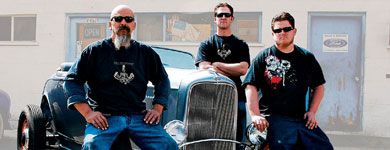
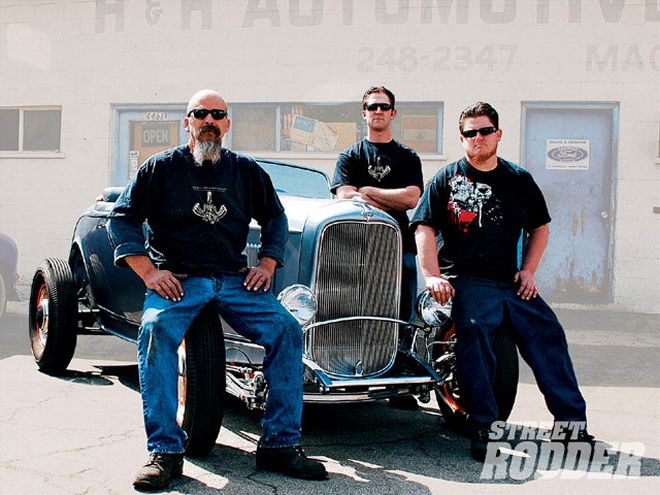 H&H Flathead's Max Herman Jr, Mike Herman, and Max Herman III (from L to R) are the Flathead experts that have offered to give me (and in turn, you) an education in the care and feeding of the Ford Flathead. I'm really looking forward to the actual rebuild process. Heck, even this introduction has been a real eye opener!
H&H Flathead's Max Herman Jr, Mike Herman, and Max Herman III (from L to R) are the Flathead experts that have offered to give me (and in turn, you) an education in the care and feeding of the Ford Flathead. I'm really looking forward to the actual rebuild process. Heck, even this introduction has been a real eye opener!
You know, even though the Ford Flathead story is an old one, there never seems to be a shortage of fresh ears and curiosity regarding the subject.
Surprisingly, though I've been a diehard traditional hot rod fan from the very start, I've never run a Flathead in any of my hot rods. It's kinda strange, considering my old school inclination and the fact that the Flathead is the epitome of early rodding (and arguably one of the most famous V-8 engines of all time). Heck, one woulda thought the Flathead an obvious choice for me. Upon reflection, though, I think I steered away from the Flathead out of, well, apprehension I guess. Cutting my teeth on junior high auto shop small-block Chevys provided me with a level of understanding and, for lack of a better word, comfort with the OHV engine. The side-valve V-8 was in all honesty a mystery to me, a mystery I kinda pushed to the "back burner" as I relied on the more modern powerplants I'd felt comfortable with since the beginning.
Well, recently a situation occurred that's given me the motivation I've needed to shed my apprehensions-namely the acquisition of a pair of Ford Flatheads (one a runner and one a good rebuild candidate). Unfortunately, I don't know the first thing about 'em. But fortunately, I'm lucky enough to know some folks that do, H&H Flatheads in La Crescenta, California. So, since my plan is to dress the runner up a bit and go through the rebuildable core completely, I figured since I'm going to get an in-depth education as I go, it'd only be right for me to share the wealth, so to speak.
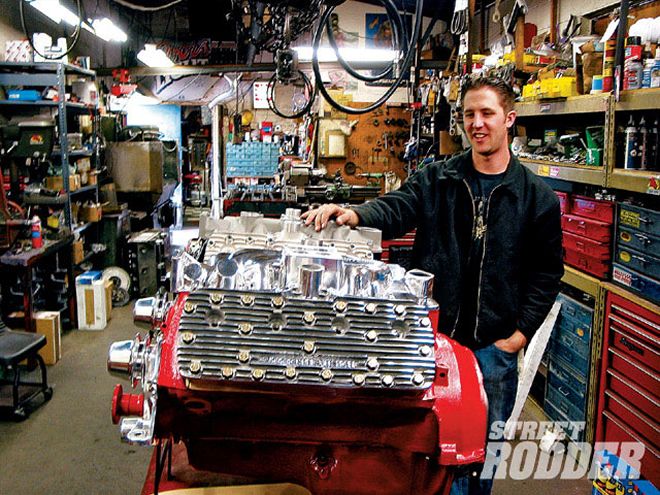 Mike is the resident V-8 whiz (now that his dad has begun to step back and focus on R&D projects, that is) and he'll do his best to teach me a small fraction of what he knows about Flatheads. The Hermans pump out a constant stream of Flathead V-8s and bangers (from mild to wild) every month, and H&H Flathead engines find their way between the framerails of rods and customs all over the world.
Mike is the resident V-8 whiz (now that his dad has begun to step back and focus on R&D projects, that is) and he'll do his best to teach me a small fraction of what he knows about Flatheads. The Hermans pump out a constant stream of Flathead V-8s and bangers (from mild to wild) every month, and H&H Flathead engines find their way between the framerails of rods and customs all over the world.
But before we get going, lemme give ya a bit of background on my educators, whom I'm proud to call my friends. H&H Flatheads in its present form was started back in '72 with the company rebuilding all early Ford engines (from Model T, A, Bs, and V-8 Flatheads) as its sole focus. It's always been a family business that's presently headed up by Mike Herman, the resident V-8 Flathead expert, four-banger guru Max Herman III, and the man who passed on all of his precious skills to his sons, Max Herman Jr. At the moment, H&H is in its 3rd generation of engine builders (though by the time you read this, the fourth will have arrived and no doubt be prepped for training) and has over the years become one of the nation's foremost performance Flathead builders and suppliers. In fact, they're now home to Navarro Racing Equipment as well as the new S.C.o.T blower-who better to glom an education from, eh?
Okay, since I've already admitted that I'm a virtual Flathead fathead, my education is gonna have to start right from the basics. With this in mind, I thought it smart to start out by asking Mike a few questions that'd been floating around in my head.
RIZ: Can a Flathead V-8 (or Banger for that matter) really be a reliable engine for a daily driven hot rod?
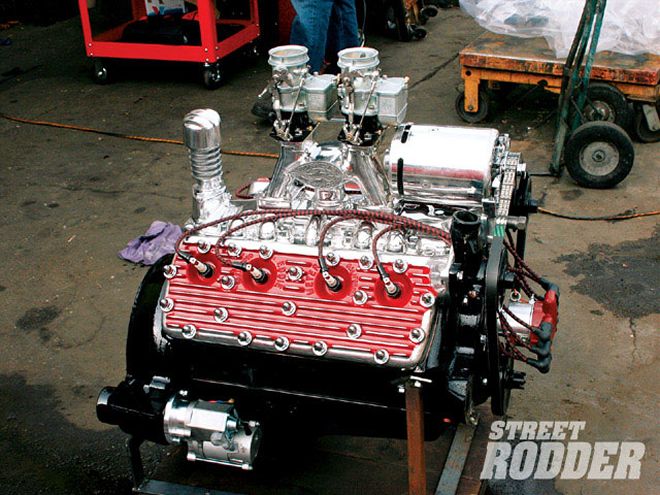 When I swung by the shop the other day to get my initial questions answered, the guys had a few engines buttoned up and ready to ship to customers. This one was waiting to be crated up when I grabbed this snapshot. Is this beautiful or what?
When I swung by the shop the other day to get my initial questions answered, the guys had a few engines buttoned up and ready to ship to customers. This one was waiting to be crated up when I grabbed this snapshot. Is this beautiful or what?
MH: Flatheads were daily drivers for many years and can be very reliable. Once we get done with them they start up every time and can run all day long. There are a few of my customers that do use them as their only transportation, and they'll work just fine if you take the steps needed to build them right.
RIZ: When considering a Flathead as a powerplant for a hot rod project, is there a particular year or model engine that is preferable?
MH: I prefer the 1949-53 8BA Flathead because it has a side mount distributor and a timing setup that makes it easier to time and tune. They also can be modified to accept the early style heads so you can get the early look and the ease of the later distributor.
RIZ: What are the major differences between early and later Flatheads, and when (what years) did they change?
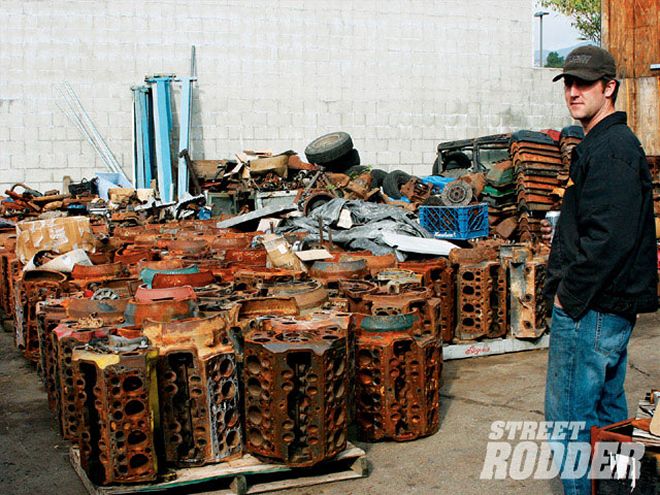 As Mike showed me around and began to answer my initial list of questions, we wandered out back so he could point out some of the differences between the earlier and later Flatheads. When we rounded the corner I nearly fell over when I caught sight of H&H's pile of rebuildable cores (this image shows only a small portion of the cores they have on hand, by the way). I'd always assumed that Flatheads were like hen's teeth, but Mike assured me that there's still plenty of good rebuildable cores out there. In fact, there's no need to even possess a Flathead of your own to get going-all you need is the urge, and Mike will take care of the rest!
As Mike showed me around and began to answer my initial list of questions, we wandered out back so he could point out some of the differences between the earlier and later Flatheads. When we rounded the corner I nearly fell over when I caught sight of H&H's pile of rebuildable cores (this image shows only a small portion of the cores they have on hand, by the way). I'd always assumed that Flatheads were like hen's teeth, but Mike assured me that there's still plenty of good rebuildable cores out there. In fact, there's no need to even possess a Flathead of your own to get going-all you need is the urge, and Mike will take care of the rest!
MH: Well, let's see, off the top of my head, the '32 221ci engines had babbitt mains, water pumps in the head, motor mounts on front of the block, 21 stud heads, and water pumps in heads. From '33 to early '36 they still had babbitt mains, 21 stud heads, water pumps in the heads, and motor mounts that doubled as the lower water necks. Later '36s went to insert type mains, but the balance of their configuration remained the same. In '37 the water outlets moved to the center of heads, and the water pumps to the block (the same held true for early '38s). In late '38 to '42 they converted to 24 stud heads. As an aside, the '39-42 Mercs were 239ci and used three-bolt distributors. The '46-48 (59A) engines were bumped from 221ci to 239ci for both Ford and Mercury, and used front-mounted two-bolt distributors. In '49 to '53 Fords the 239ci switched to a side-mount distributor configuration and the water outlets were moved to the front of the heads. The '49-53 Merc grew to 255ci (with a 4-inch crank stroke) used special water pumps, and had staggered mount thin drive belts.
RIZ: What would I look for when considering a rebuildable engine or core? And how would I go about selecting a Flathead rebuild prospect (at a swap meet, or in some guy's garage) without ending up with an unusable piece of junk?
MH: Anything with a 59 cast on the bell housing, or go for a '49-53 block that hasn't been underwater for fifty years. In other words, we can fix anything. In any case, you want to make sure the bore size is on the small side so you won't have to go through the expense of sleeving the block-you'll also want to check the pan rails for huge cracks, too.
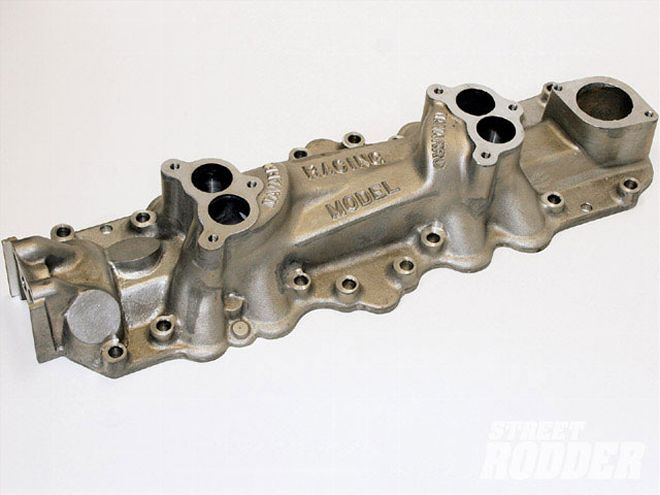 Not long ago Mike acquired Navarro Engineering from his close friend Barney Navarro and has proceeded to continue manufacturing the Navarro line of speed equipment. This dual-carb intake is just one of many high-quality offerings available in the line these days.
Not long ago Mike acquired Navarro Engineering from his close friend Barney Navarro and has proceeded to continue manufacturing the Navarro line of speed equipment. This dual-carb intake is just one of many high-quality offerings available in the line these days.
RIZ: Once I have a rebuildable block, what's the first step (i.e. tear down, machine work, etc.)?
MH: The first step is tearing down and acid dipping the block get the core sand and rust out of it. Then we Magnuflux the block and fix any cracks.
RIZ: What rebuild/replacement parts are available for Flatheads these days?
MH: Nearly everything is available today for the Flatheads. From all size pistons, rings, bearings, speed equipment, distributors, carbs like Stromberg 97s, Demon 98s, and Holley 390s. You can even get new hollow body adjustable lifters, Isky cams, and, of course, a full line of Navarro parts and S.Co.T. superchargers from H&H.
RIZ: Are there any components needed for a rebuild that are not available or that are extremely rare? In other words, if I find a Flathead rebuild prospect (in pieces or together) what items, if any, must I make sure are not missing?
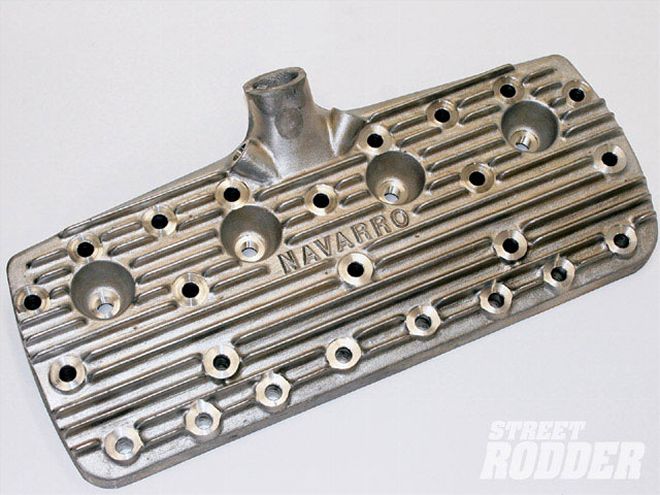 As you'll see when you check out the websites of the manufacturers listed in the source box of this story, when it comes to Flathead speed and replacement parts, the selection is much larger than one would imagine. Names like Navarro, Edelbrock, Offenhauser, Sharp, Eddie Meyer, Barron, and Cyclone are available from H&H and many other suppliers these days, and modern manufacturing techniques have ensured that their quality is top-notch these days.
As you'll see when you check out the websites of the manufacturers listed in the source box of this story, when it comes to Flathead speed and replacement parts, the selection is much larger than one would imagine. Names like Navarro, Edelbrock, Offenhauser, Sharp, Eddie Meyer, Barron, and Cyclone are available from H&H and many other suppliers these days, and modern manufacturing techniques have ensured that their quality is top-notch these days.
MH: Well, there's always the early stuff for the 21-stud motors that are hard to find, like the motor mounts and fans. Early rod bearings are hard to find, too, along with some V-8 60 parts. But for the most part I can almost supply everything available from the aftermarket.
RIZ: What combination of parts and machining would you suggest for a streetable Flathead-one that might be used as a daily driver versus the combination of parts and machining for a high-horsepower Flathead-one that would see limited use?
MH: You can use a few different combos for a daily driver. A bone stock motor can run all day long, and one equipped with aluminum heads and two carbs runs great. A good 3/4-cam always helps with the get up and go. I always recommend updating your ignition to at least dual points and I always suggest replacing water pumps no matter what. For one that's a bit more muscular, I'd suggest stroking it to 4 1/8 x3 5/16 (284ci), adding a more aggressive cam (like a Winfield SU 1A or SU 1R), and three carbs and aluminum heads. That'd do the trick.
RIZ: Is supercharging a Flathead a viable option?
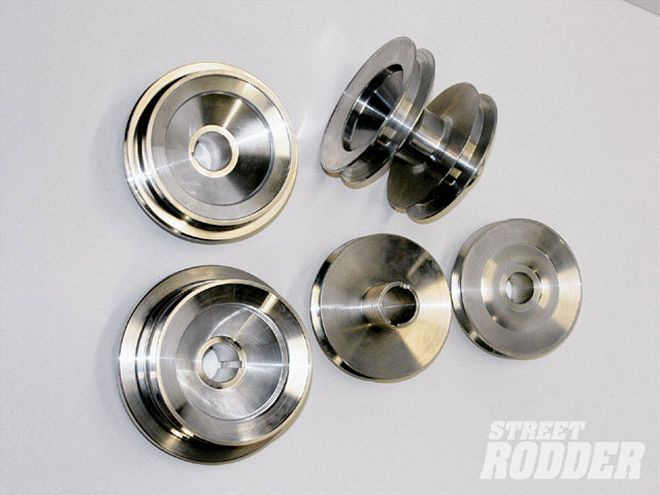 As I said earlier, Max Jr. is always busy in the R&D end of the business. This new line of CNC-machined billet pulleys are just the latest offerings H&H has made available to the Flathead aficionado.
As I said earlier, Max Jr. is always busy in the R&D end of the business. This new line of CNC-machined billet pulleys are just the latest offerings H&H has made available to the Flathead aficionado.
MH: Supercharging a Flathead as a daily driver is an excellent option, or I can make it way more aggressive and get some good horsepower out of it. The engine prep is the same for both, but when we want hp we put our own very strong cam and a little longer stroke. It really wakes them up with a bigger cam.
RIZ: I've always heard that Flatheads run hot or constantly overheat. Is this true, or a myth? If it's true that they run hot, what can be done to rectify that problem?
MH: Properly built/maintained Flatheads do not run hot. That myth started back when people did not take care of their cars or builders didn't know what they were doing. Nowadays with better water pumps and modern radiators from the aftermarket, there shouldn't be much in the way of cooling problems.
With these concerns addressed, I'm feeling much more confident with the idea of givin' up my modern OHVs for a couple of Flatheads. In the near future I'm gonna be back to show you what in the way of aftermarket parts I've chosen to add to my running Flathead, and I'm going to chronicle step by step the pros at H&H rebuilding my core engine. Both should be interesting and informative to say the least. Meanwhile, let's take a look at a fraction of what's available for Flatheads from the aftermarket. And be sure to check out the accompanying source box for a listing of Flathead parts suppliers and their websites-once I began paying attention, I was amazed by how much is available these days! I think I'm going to enjoy getting one step closer to building a couple of truly traditional hot rods, and I'm sure you will be, too!